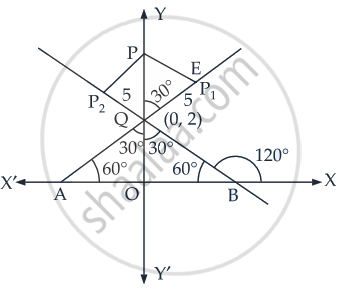Advertisements
Advertisements
प्रश्न
P1, P2 are points on either of the two lines
उत्तर
Given lines are
⇒
And
Slope of equation (i) is tan θ =
∴ θ = 60°
Slope of equation (ii) is tan q
∴ θ = 120°
Solving equation (i) and equation (ii) we get
2y = 4
⇒ y = 2
Putting the value of y is eq. (i) we get
x = 0
∴ Point of intersection of line (i) and (ii) is Q(0, 2)
∴ QO = 2
In ΔPEQ,
cos 30° =
∴ PQ =
∴ OP = OQ + PQ
=
Hence, the coordinates of the foot of perpendicular =
APPEARS IN
संबंधित प्रश्न
Draw a quadrilateral in the Cartesian plane, whose vertices are (–4, 5), (0, 7), (5, –5) and (–4, –2). Also, find its area.
Find the distance between P (x1, y1) and Q (x2, y2) when :
- PQ is parallel to the y-axis,
- PQ is parallel to the x-axis
Find a point on the x-axis, which is equidistant from the points (7, 6) and (3, 4).
Without using the Pythagoras theorem, show that the points (4, 4), (3, 5) and (–1, –1) are the vertices of a right angled triangle.
Find the values of k for which the line (k–3) x – (4 – k2) y + k2 –7k + 6 = 0 is
- Parallel to the x-axis,
- Parallel to the y-axis,
- Passing through the origin.
Find the slope of the lines which make the following angle with the positive direction of x-axis:
State whether the two lines in each of the following is parallel, perpendicular or neither.
Through (6, 3) and (1, 1); through (−2, 5) and (2, −5)
State whether the two lines in each of the following is parallel, perpendicular or neither.
Through (3, 15) and (16, 6); through (−5, 3) and (8, 2).
Using the method of slope, show that the following points are collinear A (4, 8), B (5, 12), C (9, 28).
Find the equation of a straight line with slope − 1/3 and y-intercept − 4.
The line through (h, 3) and (4, 1) intersects the line 7x − 9y − 19 = 0 at right angle. Find the value of h.
Prove that the points (2, −1), (0, 2), (2, 3) and (4, 0) are the coordinates of the vertices of a parallelogram and find the angle between its diagonals.
Show that the line a2x + ay + 1 = 0 is perpendicular to the line x − ay = 1 for all non-zero real values of a.
Write the coordinates of the image of the point (3, 8) in the line x + 3y − 7 = 0.
The acute angle between the medians drawn from the acute angles of a right angled isosceles triangle is
The angle between the lines 2x − y + 3 = 0 and x + 2y + 3 = 0 is
The reflection of the point (4, −13) about the line 5x + y + 6 = 0 is
If the line joining two points A(2, 0) and B(3, 1) is rotated about A in anticlock wise direction through an angle of 15°. Find the equation of the line in new position.
A ray of light coming from the point (1, 2) is reflected at a point A on the x-axis and then passes through the point (5, 3). Find the coordinates of the point A.
The equation of the line passing through (1, 2) and perpendicular to x + y + 7 = 0 is ______.
The intercept cut off by a line from y-axis is twice than that from x-axis, and the line passes through the point (1, 2). The equation of the line is ______.
Find the angle between the lines y =
Slope of a line which cuts off intercepts of equal lengths on the axes is ______.
The coordinates of the foot of perpendiculars from the point (2, 3) on the line y = 3x + 4 is given by ______.
The points (3, 4) and (2, – 6) are situated on the ______ of the line 3x – 4y – 8 = 0.
The points A(– 2, 1), B(0, 5), C(– 1, 2) are collinear.
The vertex of an equilateral triangle is (2, 3) and the equation of the opposite side is x + y = 2. Then the other two sides are y – 3 =
